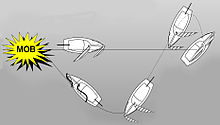- Man overboard rescue turn
-
A man overboard rescue turn is a sailing maneuver usually implemented immediately when it is learned that there is a man overboard. To maneuver closer to the person's location, implementations of the principles described are: the quick turn (also known as the Q-turn or the figure eight turn), the Anderson turn, the Williamson turn, and the Scharnow turn.
Contents
Quick turn
The quick turn is the traditional response to a man overboard emergency on a sailboat. Despite many new approaches, it is still a robust strategy and often the best method. Certainly when the crew is short handed, or when the vessel is in heavy weather, the quick turn method has a lot of merit because it avoids a jibe.
As is shown in the drawing, the quick turn is essentially a figure eight. On a sailboat it consists of the following steps:
- Change course to a beam reach and hold for 15 seconds
- Head into the wind and tack, leave the jib fluttering
- Veer off until the boat is at a broad reach
- Turn upwind until the vessel is pointing at the victim; at this point the vessel should be on a close reach.
- Slacken the mainsail until the vessel comes to a stop with the victim in the lee side of the boat
Anderson turn

The Anderson turn is a maneuver used to bring a ship or boat back to a point it previously passed through, often for the purpose of recovering a man overboard, an emergency situation in almost all circumstances.
The Anderson turn is most appropriate when the point to be reached remains clearly visible. For other situations, a Scharnow turn or a Williamson turn might be more appropriate. Both will require more time before returning to the point in question.
- If the turn is in response to a man overboard, stop the engines.
- Put the rudder over full. If in response to a man overboard, put the rudder toward the person (e.g., if the person fell over the starboard side, put the rudder over full to starboard).
- When clear of the person, go all ahead full, still using full rudder.
- After deviating from the original course by about 240 degrees (about 2/3 of a complete circle), back the engines 2/3 or full.
- Stop the engines when the target point is 15 degrees off the bow. Ease the rudder and back the engines as required.
If dealing with a man overboard, always bring the vessel upwind of the person. Stop the vessel in the water with the person well forward of the propellers.
Williamson turn

The Williamson turn is a maneuver used to bring a ship or boat under power back to a point it previously passed through, often for the purpose of recovering a man overboard. It was named for John Williamson, USNR, who used it in 1943. However, according to Uncommon Carriers by John McPhee, the maneuver was originally called the "Butakov pipe" and was used in the Russo-Japanese War as a way of keeping guns at the same distance from an enemy.[1]
The Williamson turn is most appropriate at night or in reduced visibility, or if the point can be allowed to go (or already has gone) out of sight, but is still relatively near. For other situations, an Anderson turn (quickest method) or a Scharnow turn might be more appropriate. The choice will in large part depend on prevailing wind and weather conditions. It was also used by U.S. Navy nuclear submarines to clear their sonar dead zones.[2]
- Put the rudder over full.
- If in response to a man overboard, put the rudder toward the person (e.g., if the person fell over the starboard side, put the rudder over starboard full).
- After deviating from the original course by about 60 degrees, shift the rudder full to the opposite side.
- When heading about 20 degrees short of the reciprocal, put the rudder amidships so that vessel will turn onto the reciprocal course.
- Bring the vessel upwind of the person, stop the vessel in the water with the person alongside, well forward of the propellers
If dealing with a man overboard, always bring the vessel upwind of the person. Stop the vessel in the water with the person well forward of the propellers.
Scharnow turn

The Scharnow turn is a maneuver used to bring a ship or boat back to a point it previously passed through, often for the purpose of recovering a man overboard. It was developed by and named for Ulrich Scharnow.
The Scharnow turn is most appropriate when the point to be reached is significantly further astern than the vessel's turning radius. For other situations, an Anderson turn or a Williamson turn might be more appropriate.
- Put the rudder over hard. If in response to a man overboard, put the rudder toward the person (e.g., if the person fell over the starboard side, put the rudder over hard to starboard).
- After deviating from the original course by about 240 degrees, shift the rudder hard to the opposite side.
- When heading about 20 degrees short of the reciprocal course, put the rudder amidships so that vessel will turn onto the reciprocal course.
If dealing with a man overboard, always bring the vessel upwind of the person. Stop the vessel in the water with the person well forward of the propellers.
See also
References
External links
Categories:- Sailing manoeuvres
- Water transport
Wikimedia Foundation. 2010.

